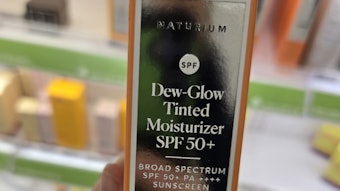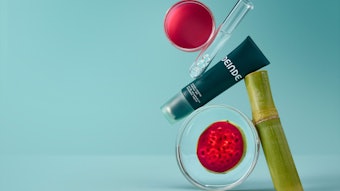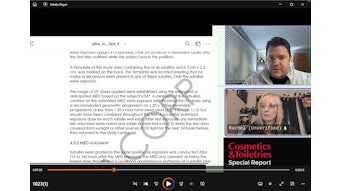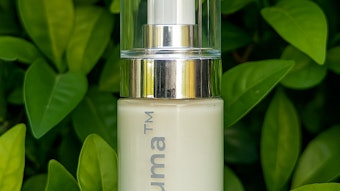
To read this article in its entirety, click through to your April 2020 digital magazine. . .
Sun protection is practically ubiquitous in products today; from color cosmetics and facial creams to even hair and scalp protection. Whether users finally understand the dangers of over-exposure, or the undesired effects of premature aging have made a bigger impact, the bottom line is there’s a surge in demand for sun protection—to the tune of a 5.8% CAGR between 2016 and 2024, according to Transparency Market Research.1
Sun protection as a category also has experienced an evolution. Gone are the days of just “UV protection.” Technology has empowered our understanding of the biological effects of UV-A versus UV-B, infrared and even high energy visible/blue light protection. In fact, as we’ve learned, the sources of these wavelengths are no longer limited to the sun or even the duration of direct exposure.
For one, light emissions from our personal devices are a new threat—which actually makes the designation of sun protection in and of itself a misnomer. And, new research points to the fact that DNA damage continues even in the dark, after direct exposure ceases.2
Add to this the fact that traditional sunscreens incorporate skin care benefits and vice versa, and the very idea of a stand-alone sun protection category becomes almost obsolete, replaced by skin care enhanced by protection against pollutants, heat, cold and all the elements (including sun). Whatever we call it, there remains a need to protect human skin against electromagnetic radiation—and a brief survey of the literature and industry experts, provided here, demonstrates some recent insights in this arena.
Visible and Infrared Wavelengths
Singer and co-authors addressed the need to further explore approaches to filter visible and near-infrared wavelengths. Their paper, published in Current Opinion in Pharmacology, underlined the specificity of sun protection, i.e., UV protection. “…There is preliminary data that besides UV radiation, also visible light (VIS) and near infrared A (IRA) radiation may have harmful effects on skin, resulting in photoaging and even cancer induction,” they wrote, adding that antioxidants and DNA repair enzymes are being incorporated into sunscreens to enhance skin protection before and even after sun exposure. Furthermore, they point to the need to more closely examine recent concerns over the reported negative impact of specific UV filters on the environment, for example, coral bleaching.3
Howard Epstein, Ph.D., director of technical services for EMD Performance Materials, underlined the industry’s interest in visible and infrared wavelengths, too. “There is growing interest in blue light protection and to some extent, IR-A protection as well,” he writes. “What is interesting about blue light is this particular wavelength (500-700 nm) seems to have a more visible impact on darker skin types.” He added that research by his company suggests there are two mechanisms that may explain this effect.
“One pathway is an oxidative mechanism, and the second is a non-oxidative biological receptor located on the surface of the melanocyte, known as opsin-3. As we gain more understanding regarding how these receptors interact with each other, we will move closer to personalized skin care,” he notes. Or perhaps even custom sun care?
Indeed, high-energy visible (HEV) or blue light appears to deserve specialized attention. As Epstein explained, his company has evaluated European-marketed sunscreen products and found that high SPFs, i.e., 30 and 50, actually do not protect against blue light.
In relation, EMD tested some of its ingredients for efficacy in this regard. “Coated inorganic filters can mitigate HEV,” Epstein says. “We evaluated Eusolex-TS (INCI: Titanium Dioxide (and) Alumina (and) Stearic Acid), Eusolex T-PEO (INCI: Titanium Dioxide (and) Alumina (and) Manganese Dioxide) and Eusolex T-AVO (INCI: Titanium Dioxide (and) Silica) [and found these] to be quite effective. We also confirmed that skin color-correcting fillers can provide HEV light mitigation, e.g., RonaFlair Balance Blue (INCI: Titanium Dioxide (and) Mica (and) Tin Oxide).”
Personalized Protection
How else might sun care be personalized? Epstein expanded, “To me, personalized skin care means making good skin care products better skin care products. It means accurately predicting the most appropriate skin care regimen based on an individual’s skin type, diet and lifestyle.”
Epstein shared his positive outlook on just how this might be accomplished. “We have made great advances in understanding how ingredients work. Using an individual’s gene profile, and with a better understanding of cell communication, we will have the ability to suggest the best ingredients to use. Opportunities will be in new targeted antioxidants and ingredients with light-protective properties.”
DNA Protection Factor
Josse, et al., recently proposed, in the British Journal of Dermatology,4 a method to determine a DNA protection factor for sun care products. As described in the article abstract, “Solar UV radiation is readily absorbed by DNA and triggers the formation of dimeric pyrimidine photoproducts such as cyclobutane pyrimidine dimers (CPDs).” Their work (currently in production) appears to focus on the capability of products to decrease this negative biological effect.
Calcium Carbonate Booster
A recent patent5 assigned to Omya International describes a functionalized calcium carbonate to boost sun protection efficacy. Disclosed is a composition providing UV-A and/or UV-B protection comprising at least one inorganic UV filter and surface-reacted calcium carbonate. By adding this calcium carbonate, the inventors claim it is possible to reduce the amount of inorganic UV filter required to achieve the desired SPF. They note this may be particularly advantageous in cases where an inorganic UV filter is nano-sized, since the amount of nano-sized materials that may be present in cosmetic compositions is regulated and limited in many countries.
Bio-compatible and Biodegradable Organosilica Nanoparticles
Work conducted by Yoo, et al., sought to address the safety and aesthetic limitations of currently available sun protection materials. Their paper, published in the American Chemical Society’s (ACS’s) Applied Materials & Interfaces,6 explains the development of, “biocompatible and biodegradable sunscreens by facile synthesis of organosilica nanoparticles (o-SNPs) with self-encapsulated phenyl motifs using phenylsilane precursors.” According to the paper, the physical structure of these materials is controlled such that they are large enough to reflect UVA but small enough to go unnoticed on skin. They also are said to generate a negligible amount of ROS upon UV exposure, and to adhere to the outer layers of skin without penetration.
Permeation Prevention
In relation, Young Baek Kim, Ph.D., president and professor of Nano and Micro Technologies, Inc. (N&M), and PaiChai University, respectively, emphasizes concerns overs sunscreens penetrating the skin. “Many sunscreens contain skin-permeable UV filters in concentrations higher than 20% w/w,” he writes. “The U.S. Food and Drug Administration’s (FDA’s) recent report on the absorption of filters into the bloodstream might have stirred the market a little bit. Especially in Asia, many people apply sunscreens on daily basis.” He added that Asian consumers are, indeed, concerned about the safety of sunscreens. “The market for safer sunscreens is not [something] the cosmetics industry should wait for the development of. [It] is a market the cosmetics industry should develop [now] for users’ safety.”
Furthermore, he adds that long-lasting sunscreens, free from aesthetic and safety issues, are pursued and highly needed by many consumers. “With skin troubles, pregnancy, children and [outdoor jobs exposing workers] to the sun long periods time, if offerings are manufactured at reasonable prices, the market will be huge.”
. . .Read more in our April 2020 digital edition. . .
References
- Transparency Market Research. (2018, Dec 17). Sun care market is expected to reach US$24.9 billion by 2024; Growing awareness of personal care to boost global market, says TMR. https://www.prnewswire.com/news-releases/sun-care-market-is-expected-to-reach-us-24-9-billion-by-2024-growing-awareness-of-personal-care-to-boost-global-market-says-tmr-882935452.html
- Grabenhofer, R. (2019, Dec 10). Acetyl zingerone prevents dark CPD formation in skin. https://www.cosmeticsandtoiletries.com/research/universitydata/Acetyl-Zingerone-Prevents-Dark-CPD-Formation-in-Skin-566051761.html
- Singer, S., Karrer, S. and Berneberg, M. (2019, Jun). Modern sun protection. Current Opinion in Pharmacology, 46 24-28. https://doi.org/10.1016/j.coph.2018.12.006
- Josse, G., Gravier, E. and Douki, T. (2020, Feb 6). Method for the accurate determination of the DNA protection factor of sun care products. Brit J Derm. https://doi.org/10.1111/bjd.18936
- US20190380927A1 (2019, Dec 19). Functionalized calcium carbonate for sun protection boosting. Assigned to Omya. https://patents.google.com/patent/US20190380927A1/en
- Yoo, J., Kim, H., Chang, H., Park, W., Hahn, S.K. and Kwon, W. (2020, Feb 5). Biocompatible organosilica nanoparticles with self-encapsulated phenyl motifs for effective UV protection. ACS Appl Mater Interfaces, 12, 8, 9062-9069. https://pubs.acs.org/doi/abs/10.1021/acsami.9b21990











